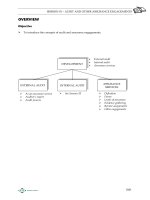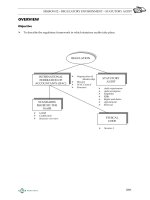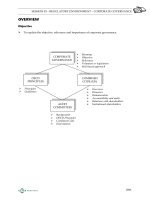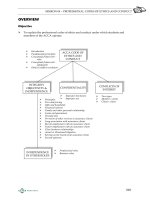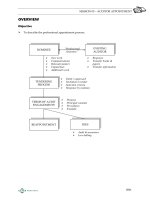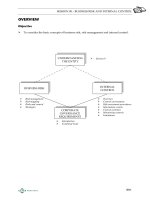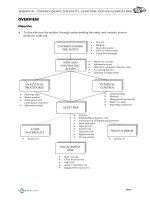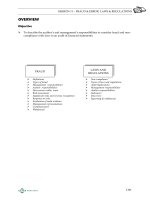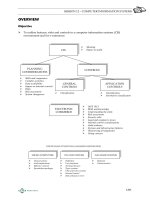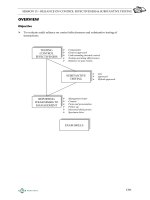ATC f8 materials f8 AA (int)session00 j08
Bạn đang xem bản rút gọn của tài liệu. Xem và tải ngay bản đầy đủ của tài liệu tại đây (281.57 KB, 18 trang )
ATC
INTERNATIONAL
ACCA
PAPER F8
AUDIT AND ASSURANCE
(INTERNATIONAL)
STUDY SYSTEM
No responsibility for loss occasioned to any person acting or refraining from action as a result of any
material in this publication can be accepted by the author, editor or publisher.
This training material has been published and prepared by Accountancy Tuition Centre Limited
16 Elmtree Road
Teddington
TW11 8ST
United Kingdom.
Editorial material Copyright Accountancy Tuition Centre (International Holdings) Limited, 2008.
All rights reserved. No part of this training material may be translated, reprinted or
reproduced or utilised in any form either in whole or in part or by any electronic,
mechanical or other means, now known or hereafter invented, including photocopying
and recording, or in any information storage and retrieval system, without permission in
writing from the Accountancy Tuition Centre Limited.
SESSION 00 – CONTENTS
Session
Page
1
Audit and other assurance engagements
0101
2
Regulatory environment – statutory audit
0201
3
Regulatory environment – corporate governance
0301
4
Professional codes of ethics and conduct
0401
5
Auditor appointment
0501
6
Documentation
0601
7
Planning
0701
8
Business risk and internal control
0801
9
Understanding the entity, audit risk and engagement risk
0901
10
Audit materiality
1001
11
Fraud & error, laws & regulations
1101
12
Computer information systems (CIS)
1201
13
Reliance on control effectiveness & substantive testing
1301
14
Audit considerations relating to entities using service organisations
1401
15
Audit evidence
1501
16
Analytical procedures
1601
17
Accounting estimates
1701
18
Using the work of an expert
1801
19
Audit sampling
1901
20
Management representations
2001
21
Computer-assisted audit techniques
2101
22
Non-current assets
2201
23
Inventory
2301
24
Trade receivables
2401
25
Loans, bank and cash
2501
26
Trade payables, accrued expenses and provisions
2601
27
Small businesses and not-for-profit organisations
2701
28
Communications with management and those charged with governance
2801
29
Audit finalisation
2901
30
The auditor’s report on financial statements
3001
31
Going concern
3101
32
Review assignments and reports
3201
33
Internal audit
3301
34
Considering the work of internal audit
3401
(iii)
SESSION 00 – CONTENTS
Appendices
35
Appendix 1 – Documentation techniques
3501
36
Appendix 2 – Transaction cycles
3601
37
Appendix 3 – Audit programs
3701
38
Appendix 4 – Review programme
3801
39
Appendix 5 – Data sources and records
3901
40
Appendix 6 – Glossary of terms
4001
Index
4101
UPDATING NOTE
The IASB reissued IAS 1 ‘Presentation of Financial Statements’ in September 2007.
Amendments to the old IAS 1 are mainly to presentation and terminology and have been
reflected throughout the study system and question banks.
Although IAS 1 does not become effective until periods beginning on or after 1 January 2009,
earlier adoption is permitted. ACCA operates a six month rule in its examinations based on
issue date, whereby accounting standards will not be examined until six months have
passed from their date of issue. Therefore the revised IAS 1 falls to be examined from the
June 2008 examinations.
Whilst these changes only refer to IFRS and are not yet reflected within ISA, terminology has
been changed for consistency throughout the F8 materials, e.g. when dealing with the “old”
IAS 1 terminology used within ISA.
The main changes can be summarised as follows:
Balance sheet
Statement of financial position
Balance sheet date
End of the reporting period (note that end of the reporting period
may also be referred to as the “year end” within the study system and question bank)
Income statement
Cash flow statement
Statement of comprehensive income (but see below)
Statement of cash flows (IAS 7 is renamed)
Events after the balance sheet date
renamed)
Events after the reporting period (IAS 10 is
The Statement of Comprehensive Income basically consists of two elements – an income
statement (the same as the old IAS 1 format) plus other comprehensive income comprising,
for example, gains on revaluations, cash-flow hedges, translation of foreign operations and
actuarial gains (all of which are still analysed within a statement of changes in equity).
Effectively, the only element that may be dealt within F8 will be the gains on revaluations.
Thus the Statements of comprehensive income used throughout F8 are the same as the old
IAS 1 Income statements.
(iv)
SESSION 00 – SYLLABUS
Introduction
This Study System has been specifically written for The Association of Chartered Certified
Accountants Paper F8 Examination, Audit and Assurance (International).
It provides comprehensive coverage of the core syllabus areas and is designed to be used
both as a reference text and interactively with the ATC Learning System to provide you with
the knowledge, skill and confidence to succeed in your ACCA studies.
SYLLABUS
Position of the paper in the overall syllabus
Paper F8 assumes knowledge and understanding developed by Papers F3 Financial
Accounting (FA) and, to some degree, F4 Corporate and Business Law (CL). In particular,
the IFRSs examined by Paper F3 could form the basis for questions on the auditing
procedures in respect of those IFRSs.
Candidates who have studied the papers in order (as recommended by the ACCA) will
have recently revised their knowledge of F3 IFRS through Paper F7 Financial Reporting
(FR). If F7 has not been recently studied, candidates are advised to review their knowledge
of IFRS as examined by F3.
Paper F8 provides the knowledge and understanding of the audit process which is then
developed in Paper P7 Advanced Auditing and Assurance (AAA). In addition, they will
also understand why an audit is required for Paper P1 Professional Accountant (PA).
Aim
To develop knowledge and understanding of the process of carrying out the assurance
engagement and its application in the context of the professional regulatory framework.
Objectives
On completion of this paper, candidates should be able to:
A
Explain the nature, purpose and scope of assurance engagements including the role of
the external audit and its regulatory and ethical framework
B
Explain the nature of internal audit and describe its role as part of overall performance
management and its relationship with the external audit
C
Demonstrate how the auditor obtains an understanding of the entity and its
environment, assesses the risk of material misstatement (whether arising from fraud or
other irregularities) and plans an audit of financial statements
D
Describe and evaluate information systems and internal controls to identify and
communicate control risks and their potential consequences, making appropriate
recommendations
E
Identify and describe the work and evidence required to meet the objectives of audit
engagements and the application of the International Standards on Auditing
(v)
SESSION 00 – SYLLABUS
F
Evaluate findings and modify the audit plan as necessary
G
Explain how the conclusions from audit work are reflected in different types of audit
report, explain the elements of each type of report.
Overview
The Audit and Assurance syllabus is essentially divided into seven areas. The syllabus starts
with the nature, purpose and scope of assurance engagements, including the statutory audit,
its regulatory environment, and introduces professional ethics relating to audit and
assurance. It then leads into internal audit, including the scope of internal audit as well as
the differences between internal audit and external audit. The syllabus then covers a range
of areas relating to an audit of financial statements. These include planning and risk
assessment, evaluating internal controls, audit evidence, and a review of the financial
statements. The final section then deals with reporting, including statutory audit reports,
management reports, and internal audit reports.
Audit framework and regulation (A)
Internal audit (B)
Planning and risk assessment (C)
Internal control (D)
Audit evidence (E)
Review (F)
Reporting (G)
(vi)
SESSION 00 – SYLLABUS
Detailed syllabus
A.
1.
2.
3.
4.
B.
1.
2.
3.
4.
5.
C.
1.
2.
3.
4.
5.
6.
7.
D.
1.
2.
3.
4.
5.
6.
E.
1.
2.
3.
4.
5.
6.
Audit Framework and Regulation
The concept of audit and other assurance engagements
Statutory audits
The regulatory environment and corporate governance
Professional ethics and ACCA’s Code of Ethics and Conduct
Internal audit
Internal audit and corporate governance
Differences between external and internal audit
The scope of the internal audit function
Outsourcing the internal audit department
Internal audit assignments
Planning and risk assessment
Objective and general principles
Understanding the entity and knowledge of the business
Assessing the risks of material misstatement and fraud
Analytical procedures
Planning an audit
Audit documentation
The work of others
Internal control
Internal control systems
The use of internal control systems by auditors
Transaction cycles
Tests of control
The evaluation of internal control components
Communication on internal control
Audit evidence
The use of assertions by auditors
Audit procedures
The audit of specific items
Audit sampling and other means of testing
Computer-assisted audit techniques
Not-for-profit organisations
(vii)
SESSION 00 – SYLLABUS
F.
1.
2.
3.
4.
Review
Subsequent events
Going concern
Management representations
Audit finalisation and the final review
G.
1.
2.
3.
Reporting
Audit reports
Reports to management
Internal audit reports
Approach to examining the syllabus
The syllabus is assessed by a three-hour paper-based examination, consisting of five
compulsory questions (no choice). The bulk of the questions will be discursive but some
questions involving computational elements will be set from time to time.
The questions will cover all areas of the syllabus.
Question 1 will be a scenario-based question worth 30 marks. Question 2 will be a
knowledge-based question worth 10 marks. Questions 3, 4 and 5 will be worth 20 marks
each.
Q1:
Q2:
Q3:
Q4:
Q5:
Number
of marks
Scenario based, multi-part question on audit procedures.
30
Short knowledge based multi-part question based on ISA and key areas 10
}
20
} Multi-part questions based on the whole syllabus
20
}
20
___
100
___
There will be 15 minutes of reading time allowed before starting the examination proper.
The advice from the examiner is to use the majority of this time to read through and think
about (plan) Question 1.
Additional information
Internal audit can be examined within any of the five questions. There is no set quantitative
element for internal audit.
Candidates need to be aware that questions involving knowledge of new examinable
regulations will not be set until at least six months after the last day of the month in which
the regulation was issued.
The Study Guide provides more detailed guidance on the syllabus. Examinable documents
are listed in the “Exam Notes” section of “student accountant”.
(viii)
SESSION 00 – SYLLABUS
The table below has been adapted from the examiner’s article in Student Accountant March
2007 explaining his approach to examining Paper F8. Candidates are well advised to
download this article from the ACCA’s website and carefully study the rest of it’s content.
Objective
Examiner’s comment
Explain the nature, purpose, and scope of
assurance engagements, including the
role of the external audit and its
regulatory and ethical framework. (A)
Questions may focus either on the factual
areas of the legal aspects of auditing, or on
the application of ethical standards in
scenario-based questions.
Explain the nature of internal audit.
Describe its role as part of overall
performance management, and its
relationship with external audit. (B)
The work of internal audit could feature in
any question in the exam. However, there
may not always be an internal
audit/review question. If internal audit is
mentioned, it is most likely to appear in
Question 1, as part of a question on audit
procedures, or in Question 4 as part of a
question on more specialised audit areas.
Demonstrate how the auditor obtains an
understanding of the entity and its
environment, assesses the risk of material
misstatement (whether arising from fraud
or other irregularities), and plans an audit
of financial statements. (C)
Questions in this area relate to the planning
of the audit. They normally feature aspects
of engagement risk, or the work of the
auditor in establishing the audit plan.
Describe and evaluate information
systems and internal controls to identify
and communicate control risks and their
potential consequences, and make
appropriate recommendations. (D)
This objective, and the next, relate to the
testing of controls, and the collection of
audit evidence using compliance and
substantive testing as appropriate. ISAs
make a clear distinction between
compliance and substantive procedures,
and this split will be followed in exam
questions. Reporting of recommendations
regarding weaknesses in internal controls,
or other issues found in an audit, will be
examined in terms of the production of a
management letter.
Identify and describe the work and
evidence required to meet the objectives
of audit engagements and the application
of ISAs. (E)
Questions are likely to focus on the
application of substantive procedures to
either statement of comprehensive income
or statement of financial position areas. It is
quite likely that both income and
statements of financial position will feature
in Question 1 with, for example,
transaction and asset/liability testing
procedures being included in the same
question (eg sales and receivables).
(ix)
SESSION 00 – SYLLABUS
Objective
Examiner’s comment
Evaluate findings and modify the audit
plan as necessary. (F)
This is potentially the most difficult area of
the syllabus. As many candidates will not
have been involved in audits, they will
probably be unclear on how to deal with
findings or errors which have an impact on
the audit plan. The overall approach to
questions in this area will therefore be to
explain the additional testing required as a
result of errors being found during the
application of audit procedures
Explain how conclusions from audit work
are reflected in different types of audit
report, explaining the elements of each
type of report. (G)
The emphasis of questions in this area will
be on explaining reports rather than having
to draft them. Extracts will normally relate
either to an explanation of how a standard
report can be modified, or (in a limited
number of cases) supplying appropriate
wording for the modification only. To be
clear, candidates will not be expected to
provide the wording for an entire audit
report (as per ISAs). Knowledge of the
content of ISAs in the 700 series will be
expected. Questions will potentially
provide extracts of audit reports, and
require candidates to identify where ISA
guidance has not been followed.
.
(x)
SESSION 00 – SYLLABUS
Examinable documents
International Standards on Auditing [ISAs](Note 1)
Number
200
210
230
240
250
260
300
315
320
330
402
500
501
505
510
520
530
540
560
570
580
610
620
700
701
710
720
Title
Preface to International Standards on Quality Control,
Auditing, Assurance and Related Services
Glossary of Terms
International Framework for Assurance Assignments
Objective and General Principles Governing an Audit of
Financial Statements
Terms of Audit Engagements
Audit Documentation (Revised)
The Auditor’s Responsibilities Relating to Fraud in an
Audit of Financial Statements (Redrafted)
Consideration of Laws and Regulations in an Audit of
Financial Statements
Communications of Audit Matters with Those Charged
with Governance
Planning an Audit of Financial Statements (Redrafted)
Identifying and Assessing the Risks of Material
Misstatement Through Understanding the Entity and its
Environment (Redrafted)
Audit Materiality
The Auditor’s Procedures in Response to Assessed Risks
(Redrafted)
Audit considerations relating to Entities Using
Service Organizations
Audit Evidence
Audit Evidence – Additional Considerations for Specific
Items
External Confirmations
Initial Engagements – Opening Balances
Analytical Procedures
Audit Sampling and Other Means of Testing
Audit of Accounting Estimates
Subsequent Events
Going Concern
Management Representations
Considering the Work of Internal Auditing
Using the Work of an Expert
The Independent Auditor’s Report on a Complete Set of
General Purpose Financial Statements (Note 2)
Modifications to the Independent Auditor’s Report
Comparatives
Other Information in Documents Containing Audited
Financial Statements
Study Session
in which covered
2
App 5
1
1
5
6
11
11
28
7
9
10
8, 9, 13
14
15
23 & 29
24
29
16
19
17
29
31
20
34
18
30
30
29
29
(xi)
SESSION 00 – SYLLABUS
International Auditing Practice Statements [IAPSs]
1000
1013
1014
Inter-bank confirmation Procedures (Note 3)
Electronic Commerce: Effect on the Audit of Financial
Statements
Reporting by Auditors on Compliance with International
Financial Reporting Standards
13
30
International Standards on Assurance Engagements [ISAEs]
Number
Title
3000
Assurance Engagements other than Audits or Reviews of
Historical Financial Information
Study Session
in which covered
2
International Standards on Review Engagements [ISREs]
Number
Title
2400
Engagements to Review Financial Statements (previously
ISA 910)
Study Session
in which covered
32
Other guidance
ACCA’s “Professional Codes of Ethics and Conduct”
The UK “Combined Code (of the Committee on Corporate Governance)” as an example of
corporate governance best practice – www.frc.org.uk/combined.cfm
Relevant articles, past examinations and examiner’s reports as published in Student
Accountant and on the ACCA’s website – www.accaglobal.com
Notes
(1) Candidates are advised that questions will be based on the principles and good practice
set out in the International Standards on Auditing. Most questions will involve some
form of application of knowledge to a specific situation or scenario. Candidates will be
required to understand auditing techniques and know how these techniques apply to
specific situations. Candidates must be able to explain the reasons why the procedures
they suggest are carried out and what they achieve.
(2) Candidates should be aware of the nature and meaning of the auditor’s report and
should be able to discuss the contents and wording of the auditor’s report. Students
would not be asked to reproduce the auditor’s report in full in an exam question, but
they may be requested to prepare the explanatory paragraphs for inclusion in the report
particularly in situations leading to the issue of a modified report.
(3) Candidates will not be examined on the audit of banks. This document is relevant to
the extent that it applies to the confirmation of financial and business relationships
between banks and their non-bank customers.
(xii)
SESSION 00 – SYLLABUS
International Accounting Standards
[IASs]
The accounting knowledge that is assumed for Paper F8 is the same as that examined in
Paper F3. Therefore students studying for Paper F8 should refer to the IFRSs listed under
Paper F3.
Number
Title
IAS 1
IAS 2
IAS 7
IAS 8
Presentation of Financial Statements
Inventories
Statement of Cash Flows (excluding group aspects)
Accounting Policies, Changes in Accounting Estimates and
Errors
Events after the Reporting Period
Property, Plant and Equipment
Revenue
Provisions, Contingent Liabilities and Contingent Assets
Intangible Assets (insofar as it relates to research and
development)
IAS 10
IAS 16
IAS 18
IAS 37
IAS 38
Study Session
in which covered
General
23
Note (1)
29
29
22
23 & 29
26
22
Notes
(1)
Statement of cash flows is not referred to in either the Paper F8 syllabus nor the
ACCA Study Guide for F8.
(xiii)
SESSION 00 – EXAMINATION TECHNIQUE
EXAMINATION TECHNIQUE
Pre-examination preparation
Read the examiner’s report. Apply the advice given within past reports when doing
practice questions. Far too many students fail because of poor examination technique.
Read the advice given below and apply when attempting questions from the study
question bank, revision question bank and any past examination papers you have taken
from the ACCA students’ website.
Time allocation
Use the majority of the 15 minutes reading time to read through and think about your
answer to Question 1, the scenario based question.
Divide your time in proportion to the marks on offer. To allocate your time multiply
the marks for each question by 1.8 minutes.
A 20 mark question should take you 20 × 1.8 = 36 minutes
Determine how much time to spend on each part of a question. This is particularly
important to Paper F8 as each question is likely to have at least 2, but probably 3, or
even 4 sub-requirements.
Stick strictly to this time allocation.
The first marks on each sub-requirement are likely to be the easiest to gain. So don’t be
tempted to spend more time on one part (eg because you know more about that topic)
instead of getting on with the next part.
Instruction v content
Before attempting a question, and in order to impress the marker, you need to
understand what the examiner requires.
Requirements (and parts thereof) specify an “instruction” and the “content” called for.
Instructions
“Describe” = set out the characteristics of
“Consider” = examine carefully/give attention to
“State” = express in words
“Explain” = make plain, clarify, elucidate
“Discuss” = examine critically, give ideas on
“Suggest” = propose/put forward
“List” = make a list/catalogue of like thinks
“Calculate” = make a calculation
Others – “identify”, “comment”, “contrast”, “conclude”, “give”
Pre-fix “briefly” = a warning not to go into too much depth.
(xiv)
SESSION 00 – EXAMINATION TECHNIQUE
Content
(Audit) work
(Audit) tests
(Manual) procedures
(Further) investigations
(Further) action
What would you do?
Call for actions
Controls = control procedures
−
−
−
−
−
−
“Ideas list”
inspect/observe/review
obtain
enquire/ask
circularise
analyse/compare
calculate/compute
“Ideas lists”
ISA 315 - risk assessment procedures, control environment + control activities
Application controls v IT controls
−
−
−
−
Completeness
Accuracy
Validity
(existence)
How? – calls for explanation.
Reasons (why?) – calls for justification. Think “because … /due to ….”
Matters/factors = “things” of relevance that you would take account of
making a decision
when
Specified techniques eg CAATs, analytical procedures
Arguments against/limitations/weaknesses – use “negative” words like “no”, “poor”,
“difficult”
Arguments for/advantages/benefits – use “positive” words like “good”, “easy”
Other contents call for specified knowledge eg criteria/circumstance
General question approach
Familiarisation
Read the requirements carefully to identify
Instructions e.g. “outline, discuss...”
Content e.g. “the audit tests, the advantages ...”
Vehicle/format e.g. “report, memo, letter...”.
Do not answer the question you think the examiner should have asked in preference to
the question printed on the exam paper.
(xv)
SESSION 00 – EXAMINATION TECHNIQUE
Do not write everything you know about a topic and hope the examiner will select the
points which are relevant to the question. This “scatter gun” tactic is a waste of
valuable time and you may receive no marks.
Plan your answer – the markers always look for evidence of thought before writing.
Make brief notes of your starting point, areas to cover and finish.
Read any scenario within a question quickly to identify company name, key dates (eg
year end), nature of business, performance.
Read through again slowly and actively, ie
highlighting key points, or
noting implications in the margin, and
noting points on a plan of your answer.
Draw together your technical knowledge and the points from the scenario. Do this by
thinking and rearranging your plan, before you write up your answer.
Plan your answer
Recall the technical knowledge you have learned relating to the content from the
requirements and your quick read of the scenario.
Identify key headings from the requirement or your plan around which to structure
your answer when you write it up.
Use the mark allocation to decide how many points you need to address. As a general
guide work to
1 mark per relevant point clearly expressed and explained (eg point, explain,
example). Remember that you must give reasons why particular actions are taken
and not just say “do it”, eg do not say “inspect purchase invoice” without saying
exactly what you are inspecting on the invoice and why (always refer to a
particular assertion).
Whilst 1 mark per sentence, is often used by candidates as a guideline, if that
sentence is not relevant to the question or does not “add value” no marks will be
given.
Ensure that each sentence you write contains a relevant point. Avoid fitting as
many points as possible into one sentence!
Present your answer
A structured answer with clearly identifiable and separable points is always preferable
to a continuous flow of text. Indicates that you have planned your answer.
Use headings, indentation and bullet points to give your answer structure and to make
it more digestible for the marker.
(xvi)
SESSION 00 – EXAMINATION TECHNIQUE
Write effectively in a style which responds to the examiner’s requirements (eg start with
actions for audit work and tests). Maintain a sentence structure and keep sentences
short and succinct.
Try to achieve a good standard of English.
Avoid playing ‘hunt the answer’ – it is in there somewhere, good luck (to the marker) in
finding what you want!
NEVER seek to write an “essay” nor provide an answer just in note form.
Review past examination papers of the examiner to appreciate their style and how
they expect you to structure your answer. The examiner wants candidates to pass, but
he cannot pass them if they do not help themselves. Examination technique is half
the battle to pass this paper.
GOOD LUCK!
(xvii)
SESSION 00 – EXAMINATION TECHNIQUE
(xviii)
